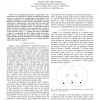Free Online Productivity Tools
i2Speak
i2Symbol
i2OCR
iTex2Img
iWeb2Print
iWeb2Shot
i2Type
iPdf2Split
iPdf2Merge
i2Bopomofo
i2Arabic
i2Style
i2Image
i2PDF
iLatex2Rtf
Sci2ools
JSAC
2007
2007
Capacity limits of cognitive radio with distributed and dynamic spectral activity
Abstract— We investigate the capacity of opportunistic communication in the presence of dynamic and distributed spectral activity, i.e. when the time varying spectral holes sensed by the cognitive transmitter are correlated but not identical to those sensed by the cognitive receiver. Using the information theoretic framework of communication with causal and non-causal side information at the transmitter and/or the receiver, we obtain analytical capacity expressions and the corresponding numerical results. We find that cognitive radio communication is robust to dynamic spectral environments even when the communication occurs in bursts of only 3 − 5 symbols. The value of handshake overhead is investigated for both lightly loaded and heavily loaded systems. We find that the capacity benefits of overhead information flow from the transmitter to the receiver is negligible while feedback information overhead in the opposite direction significantly improves capacity.
| Added | 16 Dec 2010 |
| Updated | 16 Dec 2010 |
| Type | Journal |
| Year | 2007 |
| Where | JSAC |
| Authors | Syed Ali Jafar, Sudhir Srinivasa |
Comments (0)

